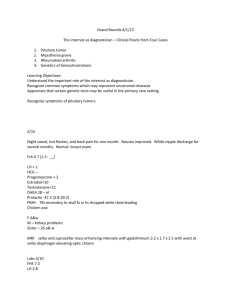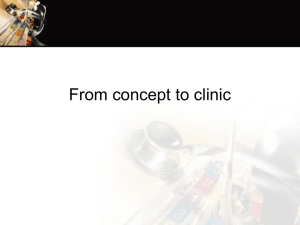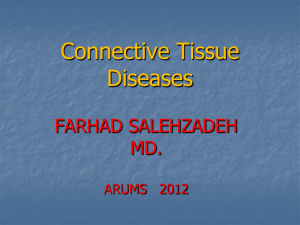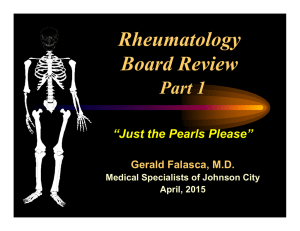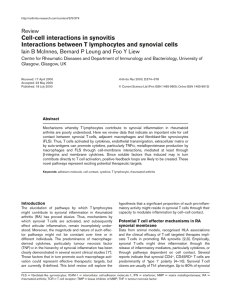FUNDAMENTALS OF CLINICAL MEDICINE
advertisement
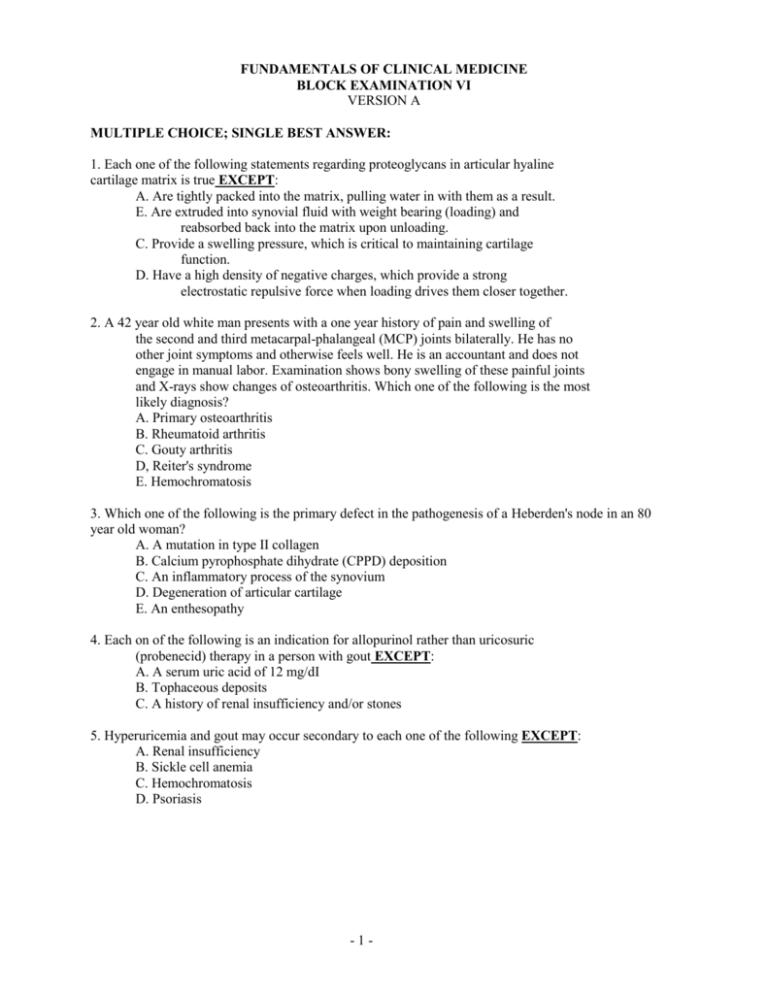
FUNDAMENTALS OF CLINICAL MEDICINE BLOCK EXAMINATION VI VERSION A MULTIPLE CHOICE; SINGLE BEST ANSWER: 1. Each one of the following statements regarding proteoglycans in articular hyaline cartilage matrix is true EXCEPT: A. Are tightly packed into the matrix, pulling water in with them as a result. E. Are extruded into synovial fluid with weight bearing (loading) and reabsorbed back into the matrix upon unloading. C. Provide a swelling pressure, which is critical to maintaining cartilage function. D. Have a high density of negative charges, which provide a strong electrostatic repulsive force when loading drives them closer together. 2. A 42 year old white man presents with a one year history of pain and swelling of the second and third metacarpal-phalangeal (MCP) joints bilaterally. He has no other joint symptoms and otherwise feels well. He is an accountant and does not engage in manual labor. Examination shows bony swelling of these painful joints and X-rays show changes of osteoarthritis. Which one of the following is the most likely diagnosis? A. Primary osteoarthritis B. Rheumatoid arthritis C. Gouty arthritis D, Reiter's syndrome E. Hemochromatosis 3. Which one of the following is the primary defect in the pathogenesis of a Heberden's node in an 80 year old woman? A. A mutation in type II collagen B. Calcium pyrophosphate dihydrate (CPPD) deposition C. An inflammatory process of the synovium D. Degeneration of articular cartilage E. An enthesopathy 4. Each on of the following is an indication for allopurinol rather than uricosuric (probenecid) therapy in a person with gout EXCEPT: A. A serum uric acid of 12 mg/dI B. Tophaceous deposits C. A history of renal insufficiency and/or stones 5. Hyperuricemia and gout may occur secondary to each one of the following EXCEPT: A. Renal insufficiency B. Sickle cell anemia C. Hemochromatosis D. Psoriasis -1- 6. A 22 year old white woman presents with a 24 hour history of pain and swelling of the right wrist. She also has had chills and fever to 102°. Physical examination reveals marked swelling, heat, erythema and tenderness of the wrist. Which ONE of the following is most likely to provide the most specific diagnostic information? A. Synovial fluid gram stain and culture B. Synovial fluid examination for crystals C. Synovial fluid white blood cell count D. Synovial fluid glucose E. A serum total hemolytic complement level 7. Which one of the following types of arthritis is most likely to involve the first carpal-metacarpal joint at the base of the thumb? A. Rheumatoid arthritis B. Osteoarthritis C. Psoriatic arthritis D. Pseudogout E. Infectious arthritis 2 8. A 20 year-old African-American woman comes to your office for evaluation of fever and a rash on her face. Her temperature is 100.8 F. Skin examination reveals a scaly, erythematous confluent eruption over both cheeks and the bridge of the nose. There is tenderness over several of the small joints of the hands, and over the right knee. Appropriate screening laboratory studies for possible lupus should include: A. ANA, CBC and UA B. ANA, CBC and anti-single stranded DNA C. Anti-double stranded DNA, anti-Sm and anti-RNP D. CBC, chem 19 and SPEP (Serum protein electrophoresis) E. CBC, UA and RPR 9. Which ONE of the following tests is specific for SLE: A. ANA B. Anti-ssDNA (Anti-single stranded DNA) C. Anti-Ro (SSA) D. Anti-Sm E. Anti-cardiolipin 10. Which of the following autoantibodies is likely to be directly involved in the pathogenesis of lupus glomerulonephritis: ANA B Anti-double stranded DNA C. Anti-Ro (SSA) D. Anti-RNP E. Anti-Sm 11. Hydroxychloroquine sulfate affects the immune system by: A. cytotoxic effects on leukocytes B. inhibition of cyclooxygenase C. neutralization of antibodies D. impaired cytotoxic T cell activity E. impaired antigen processing and presentation by macrophages -2- 12. Which of the following mechanisms does ni play a role in corticosteroid-induced osteoporosis: A. increased urinary excretion of calcium B. reduced intestinal absorption of calcium C. reduced number of osteoblasts D. reduced collagen synthesis by osteoblasts E. diminished levels of parathyroid hormone 13. A 40 year-old man is seen in his physician's office for a 2 week history of swelling, pain and stiffness in the MCP and PIP joints of the hands, the wrists and the knees. He has also noticed fevers of up to 100°F and unusual fatigue. Possible infectious causes of his condition include all of the following EXCEPT: A hepatitis B B. rubella C. mycobacterium tuberculosis D. parvovirus B19 E. HIV 14. Which of the following is NOT known to participate in the pathogenesis of rheumatoid synovitis? A. interleukin-1 B. interleukin-6 C. tumor necrosis factor alpha D. collagenase E. prostaglandin E2 15. Rheumatoid factors may contribute to joint inflammation by: A. activating CD4+ T lymphocytes B. activating osteoblasts C. suppressing collagen formation D. interleukin-2 receptor expression on T lymphocytes E. stimulating the release of prostaglandins from phagocytes 16. All of the following adverse effects may result from administration of methotrexate in the treatment of rheumatoid arthritis with the EXCEPTION OF: A. proteinuria B. neutropenia C. cirrhosis of the liver D. hypersensitivity pneumonitis E. diarrhea 17. Which of the following agents is likely to reduce the toxicity of methotrexate: A. ethanol B. aspirin C. folic acid D. vitamin B12 E. sulfamethoxazole 18. Which one of the following is typical of drug eruptions? A. The rash is always maculopapular. B. Typically occurs within the first 24 hours of initiation of a drug. C. May begin 7 - 10 days after initiation of a drug. D. Are always pruritic. E. Is associated with a decrease in eosinophils. -3- 19. Concerning the erythrocyte sedimentation rate (ESR) each one of the following statements is true EXCEPT: A. The ESR has little value in screening asymptomatic patients for disease B. The ESR measures the length of fall of the top of a column of erythrocytes in a given time interval C. The ESR is commonly elevated to a moderate extent in active inflammatory diseases D. The ESR is unaffected by the size, shape and the concentration of RBC's E. The ESR may be useful in monitoring therapy in rheumatoid arthritis 20. The "anemia of chronic disease" in most cases is: A. The result of IgG autoantibodies formed secondary to the underlying disease process B. Associated with low serum iron and reduced total iron-binding capacity C. Caused by decreased absorption of folic acid with a subsequent megaloblastic anemia D. A microangiopathic anemia caused by narrowing or obstruction of the vasculature from the primary disease process E. A result of immune-complex formation, from the patients drug therapy, attaching to the red cell membrane causing hemolysis 21. Concerning the pathologic findings seen in SLE each one of the following statements is true EXCEPT: A. Immune complexes may be deposited in the mesangial, intramembranous, subepithelial or subendothelial areas of the glomerulus B. In membranous glomerulonephritis, histologic findings are a widespread thickening of the capillary walls C. Diffuse proliferative glomerulonephritis is the mildest of the five patterns seen in SLE D. Crescent formation can be seen in diffuse proliferative glomerulonephritis E. Immunofluorescence can be useful in the diagnosis QUESTIONS 22. TRUE / FALSE 22. Monosodium urate crystals are positively birefringent when viewed under polarized light. A. TRUE B. FALSE QUESTION 23 - 25, MATCHING. EACH CHOICE MAY BE USED ONCE OR NOT AT ALL. For the following dermatologic findings match the systemic or underlying disease that is most likely to have produced these specific findings. SKIN LESION SYSTEMIC DISEASE 23. Recurrent Erythema Multiforme minor A. Staphylococcal Scalded skin syndrome 24. Mouth ulcers, fever sore throat, macular exanthem on upper trunk. B. Herpes Simplex labialis -4- C. Sezary Syndrome 25. Geographic lesions of Palpable purpura on foot in young adult with sudden illness and fever D. Meningococcemia E. Primary HIV seroconversion reaction MULTIPLE CHOICE; SINGLE BEST ANSWER: 26. Each one of the following statements regarding skin lesions in association with underlying malignancy is true EXCEPT: A. The presence of multiple seborrheic keratoses in an old person is usually a sign of internal malignancy. B. A patient with Paget's disease of the breast usually has an underlying ductal carcinoma. C. Pancreatic carcinoma may be associated with panniculitis as well as with necrotizing migratory erythema. D. A female with cobblestone lesions of the gums with a family history of cancer needs baseline mammography and frequent breast exams. E. A young adult with sudden onset of ichthyosis vulgaris and itching should be checked for Hodgkin's disease and for HIV. 27. Bullous impetigo: A. Is always a mixed infection B. Always resolves spontaneously C. Is due to Trichophyton tonsurans D. Is caused by Staphylococcus aureus E. Is caused by Herpes simplex virus. 28. The body louse is called: A. Pediculosis capitis B. Pediculosis corporis C. Pediculus humanus humanus D. Pediculus humanus capitis E. Phthirus pubis 29. Which of the following separates a true hematopoietic stem cell from committed hematopoietic progenitors. A. Capacity to differentiate B. Self-renewal C. BothAandB. D. Neither A and B. 30. Erythropoietin: A. Is regulated by blood O2 saturation levels. B. Is regulated by the Hemoglobin level in the blood. C. Is suppressed in polycythemia vera by feedback inhibition. D. Is produced principally in the liver in response to tissue hypoxia. E. Is increased in polycythemia vera resulting in abnormally increased red cell number. -5- 31. Which one of the following statements regarding HbSS disease (Sickle Cell disease) is FALSE: A. The single animo acid substitution at the 136 position in the 13-chain of the globin moiety in HbSS disease is valine for glutamic acid. B. Hyposplenism in HbSS disease makes the patients more susceptible to infections with Streptococcus viridans. C. Hyposplenism in HbSS disease makes the patients more susceptible to infections with Hemophilus influenza-B. D. Hyposplenism in HbSS disease makes the patients more susceptible to infections with Streptococcus pneumoniae. 32. A rheumatologist studied the effect of copper bracelets on 10 patients with arthritis. He measured 26 variables and found a significant lowering of blood levels for rheumatoid factor, but no effect on pain or function. He concluded that copper can effect blood levels of rheumatoid factor, but nothing else. Do you believe him? A. Yes, the more variables measured, the better the design. B. No, one needs many more patients when measuring so many variables. C. No, one can never measure the effects of more than one variable at a time. D. Yes, rheumatology is a complex discipline, and any result is useful for patient care. 33. Measures of central tendency establish ways to describe a set of data points. Among the following which is not a measure of central tendency? A. mean B. standard deviation C. mode D. median 34. You analyze the impact of a new treatment in your practice. You find that the effect is approximately the same on a number of patients, but 2 of them have results that are far from the average. You should A. Include all of the patients in the same analysis. B. Discard the data from the patients who are far from the mean. C. Analyze the first group with the usual tools and save the 2 patients for interesting case studies. D. Conclude that study is flawed, discard all the data and start anew. TRUE / FALSE: 35. The box-and-whisker plot displays medians, upper and lower quartile values, fences and specially marked outliers. This plot is useful in separating our data into sets that need special attention. A. TRUE. B. FALSE. -6- MULTIPLE CHOICE; SINGLE BEST ANSWER: 36. The distribution of the mean number of anginal-attacks per week of a large group of patients is plotted against time. The distribution is obviously confined to positive values of time and has a long tall in the direction of increasing time. You want to represent for your colleagues the center of the distribution. The center of the distribution is best represented by the: A. standard error of the mean. B. the median value. C. the mean value. D. the standard deviation. E. the kurtosis value 37. Regression of several variables is frequently used to statistically control for variables that may effect the outcome of a treatment. We have computed the least-squared equation for a group of patients and found two coefficients that are statistically significantly different from zero. The equation is y = 20 - 4 x1 + 3x2 where y = serum chol (mg/100cc) x1 = wt in kilos x2 = sys bp Controlling for wt and sys bp, what would we expect the serum chol (mg/100 cc) of a 60 kilo patient with a sys bp of 120 to be? A. 130 B. 140 C. 150 D. 160 E. 170 38. Alpha and beta errors are measures of protection against false positives and false negatives. Remember that the power of a test is 1- beta. Standard values for alpha and the power are: A. .05 and .5 B. .5 and .05 C. .05 and .8 D. .05 and .05 E. .05 and .01 39. I am participating in a clinical trial of a potent new medication that shows promise to interrupt a devastating disease process, but has serious side effects. The design of the trial should consider protection against sampling errors by adjusting the size of the treatment and placebo groups so that the alpha error and power (1-beta error) are: A. .05 and .8 B. .1 and .8 C. .001 and .2 D. .001 and .8 E. .05 and .95 -7- Questions 40 - 41 refer to the following patient information. An 1 8-year-old woman had noticed bleeding from her gums when she brushed her teeth for the past three days. She sought medical attention when she developed epistaxis (nose bleed). She had no prior history of bleeding problems, and there was no family history of bleeding. 40. Based on this information, the most likely reason for her bleeding is A. congenital platelet abnormality B, acquired platelet abnormality C. congenital factor VIII deficiency D. acquired factor VIII deficiency E. fibrinogen abnormality 41. The most helpful preliminary tests would be: A. platelet count, PT, aPTT B. fibrinogen and fibrin split products (FSP) C. 1:1 mixing study D. lupus anticoagulant test E. template bleeding time 42. Each of the following coagulation factors is dependent on the availability of vitamin K, EXCEPT: A. factor VII B. factor IX C. fibrinogen D. factor X E. prothrombin Questions 43 - 44 refer to the following patient information. Justin, a ten-year-old boy homozygous for hemoglobin S is admitted in a hemolytic crisis. 43. Common complications of this disease which this child may develop include each of the following, EXCEPT: A. gallstones B. iron deficiency C. growth retardation D. chronic leg ulcers E. splenic atrophy 44. Justin's brother has sickle cell trait. Which of the following findings would you likely see for him? A. a positive sickle cell screen (Sickle-dex) B. sickled red blood cells on the peripheral smear C. predominance (>50%) of HbS on hemoglobin electrophoresis D. normal hemoglobin electrophoresis E. splenic atrophy -8- QUESTION 45 - 47 refer to the following patient information: Twenty-two year-old Diane Harris was recently diagnosed as having Hodgkin's disease by biopsy of a cervical lymph node. 45. Which of the following would indicate a poor prognosis? A. low LDH B. three centimeter lymph node on biopsy C. mixed cellularity histology D. temperature of 98.6 E. five pound weight gain over the past 6 months 46. Diane is found to have involvement of mediastinal and retroperitoneal lymph nodes. The stage is: A. I B. II C. III D. IV E. V 47. Characteristic findings in Hodgkin's disease include each of the following, EXCEPT: A. bimodal age incidence B. Reed-Sternberg cells invariably present C. T-cell immunologic deficiency D. specific cytogenetic abnormality in tumor cells E. frequent presence of mediastinal mass in certain subtypes 48. Potential complications from chemotherapy include: A. bone marrow suppression B. infertility C. a second, therapy-related malignancy D. kidney damage E. all of the above 49. The relative incidence of cancers in children < 15 years of age is: A. Leukemia > lymphoma > brain tumors B. Lymphoma > leukemia > lymphoma C. Brain tumors > leukemia > lymphoma D. Leukemia > brain tumors > 50. The survival rate of childhood cancer is approximately: A. 20% B. 35% C. 50% D. 65% E. 80% 51. Each of the following are TRUE about the epidemiology of childhood cancer EXCEPT: A. Between 1 in every 300 to 350 children develop cancer before age 20. B. Cancer is the most common cause of death in children due to disease C. Cancer is more common than human immunodeficiency virus infection D. Most cases are due to environmental factors E. The incidence of leukemia and brain tumors -9- 52. Most physiological coagulation is initiated by: A. Factor XII and contact activation factors B. Factor IX and factor VIII C„ Factor X and factor V D. Factor VII and tissue factor E. Factor VII, factor X and TFPI 53. Which one of the following is associated with moderate thrombocytopenia (20-50,000 platelets / uL): A. 1-3 mm red skin lesions that blanch under pressure B. 1-3 mm red skin lesions that do not blanch under pressure C. spontaneous hemarthroses 54. A 20% factor VIII level in a woman is most likely due to: A, mild hemophilia A B. mild hemophilia B C. an intragenic homologous recombination of the factor VIII gene D. von Willebrand's disease E. a lupus anticoagulant 55. You are working in an Emergency Room and a 22 year old man presents with a swollen, ecchymotic jaw and continual bleeding from the socket where his wisdom tooth was removed yesterday afternoon. Your history elicits that he was diagnosed with systemic lupus last year. Your physical reveals a typical malar rash and mild inflammation of his PIP joints in addition to a massively swollen, ecchymotic left cheek and a slow ooze of blood from a wisdom tooth socket. The laboratory shows a hemoglobin of 10.5 gm%, a platelet count of 225 K / µl, a PT of 11.2 seconds and an aPTT of 58 seconds (PT normal 10.512.5 sec; aPTT normal 25-35 sec). Your next order is: A. a factor VIII level B. a lupus anticoagulant test (Russell viper venom time) C. a thrombin time and fibrinogen level D. 2 units of single donor fresh frozen plasma E. a 1:1 mix of the aPTT with normal plasma 56. Primary hemostasis, the combination of the vascular and platelet phases of coagulation, is strengthened by a fibrin meshwork (secondary hemostasis). The crosslinked fibrin polymer is completed and responsible for the strength of the clot after: A. 5-10 seconds B. 5-10 minutes C. 5-10 hours D. 5-10 days E. a few weeks 57. Before treating a patient with breast cancer using chemotherapy, hormones, cytokines or radiation it is necessary to first obtain a: A. fine needle or surgical biopsy of the lesion B. mammogram that demonstrates micro calcifications C. Tc-MIBI nuclear scan of mitochondrial receptors 58. The prognosis of any type of cancer is dependent on the: A. lymph node involvement B. presence of distant metastases C. lymphatic invasion D. vascular invasion - 10 - E. all of the above 59. Each one of the following are Oncological Emergencies EXCEPT: A. Superior vena caval syndrome B. Spinal cord compression C. Hypercalcemia D. Anemia E. Renal failure 60. The probability of recurrent disease in node negative breast cancer is approximately: A. 1 % B. 5 % C. 18 % D. 35 % E. 50% 61. 5-fluorouracil (5-FU) causes which characteristic normal tissue toxicity? Choose one answer. A. Kidney proximal tubular dysfunction B. Kidney glomerular toxicity C. Pulmonary diffusion impairment D. Cardiomyopathy E. Mucositis 62. In an Oncological emergency the following are true: A.Neither radiation nor chemotherapy are given until after a specific diagnosis of the type of primary malignancy is made using histo-pathological material. B.Treatment with surgery, radiotherapy or chemotherapy begins as soon as the emergency is recognized. C. Radiation is only given to treat the emergency Mon-Fri, from 8:00 am to 5:00 pm. D. If the emergency is metabolic in nature, such as hypercalcemia, metabolic therapy begins immediately. 63. Why do cancer cells proliferate at the expense of normal cells? A. The doubling time of cancer cells is very much shorter than normal cell doubling time. B. Cancer cells do not differentiate and therefore do not senesce, whereas normal cells differentiate, undergo senescence and die. C. Cancer cells utilize energy more efficiently than normal cells. D. Damaged DNA of cancer cells is repaired more rapidly than DNA of normal cells. QUESTIONS 64 - 66: TRUE / FALSE 64. Cells in Go are least sensitive to chemotherapy-induced cytotoxicity. A. TRUE. B. FALSE 65. Rapidly proliferating cancer cells are least sensitive to chemotherapy-induced cytotoxicity. A. TRUE. B. FALSE 66. Poorly oxygenated cells are least sensitive to chemotherapy-induced cytotoxicity. A. TRUE. - 11 - B. FALSE - 12 - ANSWERS: 1. B 2. E 3. D 4. A 5. C 6. A 7. B 8. A 9. D 10. B 11. E 12. E 13. C 14. B 15. E 16. A 17. C 18. C 19. E 20. B 21. C 22. B 23. B 24. E 25. D 26. D 27. D 28. C 29. B 30. E 31. B 32. B 33. B 34. 35. 36. 37. 38. 39. 40. 41. 42. 43. 44. 45. 46. 47. 48. 49. 50. 51. 52. 53. 54. 55. 56. 57. 58. 59. 60. 61. 62. 63. 64. 65. 66. - 13 - C A B B C D B A C B A C C D E D E D D B D E C A E D C E D B A B A







